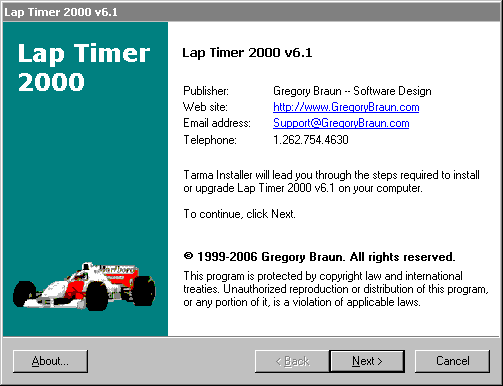Installing Lap Timer
KInstallation
To install Lap Timer 2000 on your computer simply create a new, empty folder and place the files; LAPTIMER.EXE, LAPTIMER.SYS, LAPTIMER.HLP and LAPTIMER.CNT there.
LAPTIMER.EXE The Lap Timer 2000 Application
LAPTIMER.HLP The Windows Help File
LAPTIMER.CNT The Help Contents File
LAPTIMER.SYS MS Windows 2000/XP/NT Device Driver*
KIf you installed Lap Timer 2000 using the SETUP.EXE program and selected the default installation setting, Lap Timer 2000 will be installed in the C:\Program Files\Software by Design folder.

KTo integrate Lap Timer 2000 with the MS Windows Explorer select the Help | Setup menu item to open the Lap Timer Explorer SetupLap Timer Explorer Setup property sheet.
KNote If you have an earlier version of Lap Timer 2000 installed on your computer, simply replace the LAPTIMER.EXE, LAPTIMER.SYS, LAPTIMER.HLP and LAPTIMER.CNT files with the newer versions.
K* MS Windows 2000, XP and NT systems use the LapTimer.sys device driver when accessing hardware I/O ports. The LapTimer.sys device driver will be loaded automatically when Lap Timer 2000 is launched on MS Windows 2000, XP and NT systems. If you have used earlier versions of Lap Timer 2000 you can safely remove the LapTimer.sys device driver from the C:\Windows\System32\Drivers folder.
KThe various application settings specified in the Lap Timer OptionsConfiguring Lap Timer property sheet as well as the main window’s size and location on the desktop are stored in the MS Windows System RegistrySystem Registry.
KWarning If you rename the LAPTIMER.EXE file you must also rename the LAPTIMER.SYS and LAPTIMER.HLP file using the same basename. For example if you change the Lap Timer application file name to NewName.exe, rename the help file to NewName.hlp and the device driver to NewName.sys. Do not rename the LAPTIMER.CNT file however. The SYS, HLP and CNT files must reside in the same folder as the Lap Timer application file itself.
KThe MS Windows Help program creates a pair of files associated with the LAPTIMER.HLP file. These files will have file extensions of GID and FTS. These files are used to store specific information about the help window location on the desktop and the word list used for topic searching. These two files will be created when the Lap Timer 2000 Help file is first used.
Created with the Personal Edition of HelpNDoc: Qt Help documentation made easy